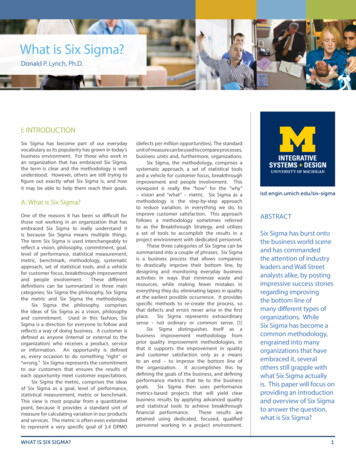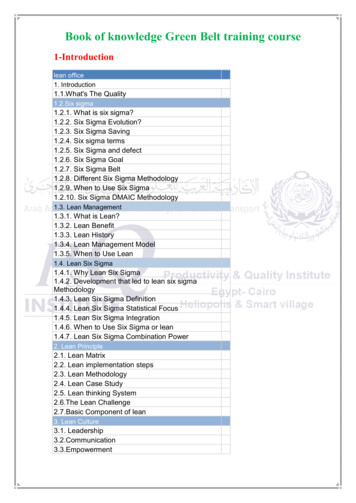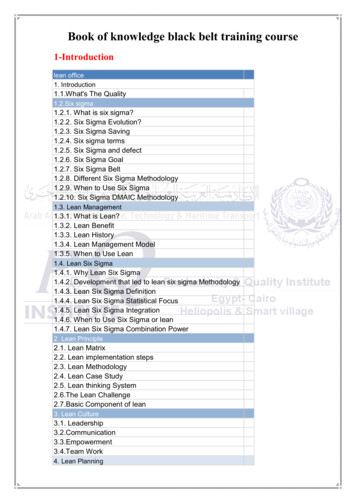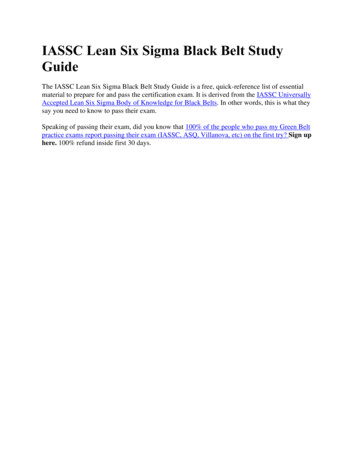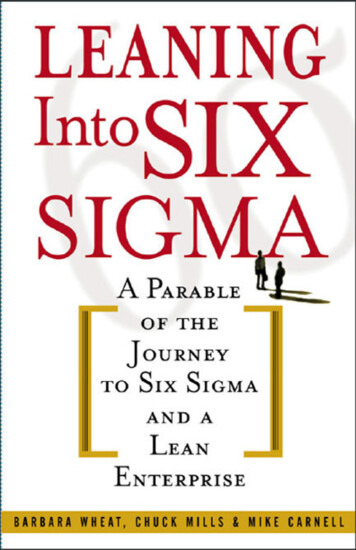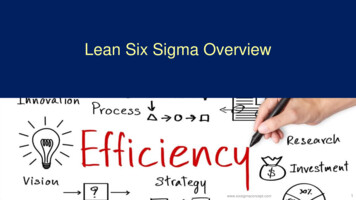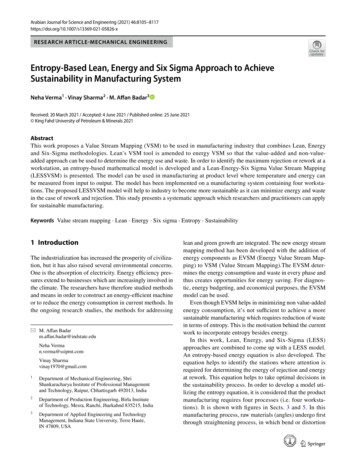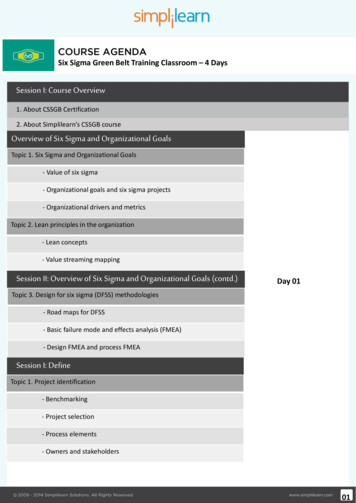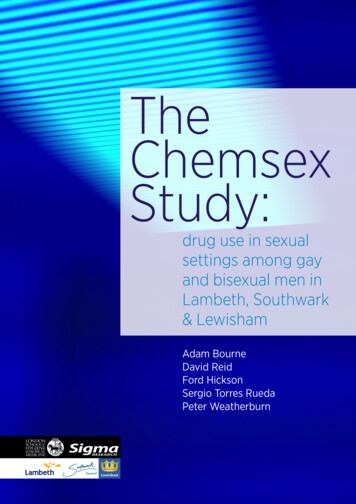
Transcription
TheChemsexStudy:drug use in sexualsettings among gayand bisexual men inLambeth, Southwark& LewishamAdam BourneDavid ReidFord HicksonSergio Torres RuedaPeter Weatherburn
ACKNOWLEDGEMENTSThis report was commissioned by the London Boroughs of Lambeth,Southwark & Lewisham. Their commissioning manager, Paul Steinberg,was the driving force behind the conception of this study and he providedsignificant practical and intellectual support at every stage. It could not havehappened without him.A large number of other people also contributed to the success of this project.Our thanks go to Monty Moncrieff (London Friend), David Stuart (56 DeanStreet), Valerie Delpech & Vicky Gilbart (Public Health England), Patrick Cash& James Eagan (QX Magazine), Simon Kilner (The Eagle), Gavin Simpson(Disco Damaged), staff of The Hoist club (Vauxhall), Phillipe Chiarella (OrangeNation), Steven Warren (RVT), Justin Harbottle (THT), Michael Peacock andMaria Kinsella (Chemsex community forums), the Vauxhall One businessassociation, Uli Lenart and Jimmy MacSweeney (Gay’s the Word), ChristopherCamplin, and Matthew Hodson (GMFA). We particularly wish to acknowledgethe support of the Metro Centre staff and volunteers (especially David Naylor,Rob Wardle and Tony Furlong) for helping to inform the study, as well ashosting and participating in focus groups. Thanks to Kathie Granger for herexpert project administration, to Gary Hammond for proof-reading and to SiânCook for her design of this report.Finally, this study would not have been possible without thirty men steppingforward to talk openly and honestly with us about their experiences. We aregreatly indebted to them. We also sincerely thank all those who took partin focus groups, as well as the staff and volunteers from community basedorganisations and sexual health clinics who gave up their time to share theirthoughts and experiences.Adam BourneLecturerSigma Research GroupLondon School of Hygiene & Tropical MedicineAdam.bourne@lshtm.ac.ukSuggested citation: Bourne A, Reid D, Hickson F, Torres Rueda S, Weatherburn P(2014) The Chemsex study: drug use in sexual settings among gay & bisexualmen in Lambeth, Southwark & Lewisham. London: Sigma Research, LondonSchool of Hygiene & Tropical Medicine. www.sigmaresearch.org.uk/chemsexPublished by Sigma Research, London School of Hygiene & Tropical Medicine. March 2014. ISBN: 978-1-906673-18-5The Chemsex Study02
TABLE OF CONTENTSAcknowledgements.2Glossary of key terms.61. Introducing ‘chemsex’.81.1 Understanding the prevalence of chemsex in London.101.2 The public health problem.101.3 Chemsex in Lambeth, Southwark and Lewisham. 111.4 Chemsex in an international context. 131.5 Overview of report. 132. Methods. 142.1. Secondary analysis of EMIS Survey data. 152.2 Qualitative interviews. 152.3 Focus groups with members of local gay community. 162.4 Focus group & interviews with community and clinical service providers. 163. Drug use among MSM living in Lambeth, Southwark and Lewisham:survey data from EMIS. 173.1 The EMIS Sample. 183.2 Sample demographic characteristics. 183.3 Injecting drug use. 193.4 Recency of drug use by men in LSL.203.5 Drug use in LSL compared with elsewhere. 223.6 Variation in drug behaviours and needs across demographic groups. 233.6.1 Age. 233.6.2 HIV testing history. 243.7 Use of gay settings. 253.8 Setting use and drug use. 263.8.1 Gay café/bar/pub use and drug use. 263.8.2 Saunas and drug use. 273.8.3 Backrooms/sex clubs and drug use. 283.8.4 Private sex parties and drug use. 293.9 Summary.30The Chemsex Study03
4. The context of chemsex. 314.1 Drugs of choice for chemsex. 324.2 Drug use initiation narratives. 334.3 Means of drug delivery including injecting. 344.4 Means of acquiring drugs. 364.5 Settings for chemsex.374.6 The social and community context of chemsex. 384.7 Summary.405. The impact of drugs on sexual pleasure and sexual performance. 415.1 Facilitating sexual confidence. 425.2 Increasing sexual desire and libido. 435.3 Intimacy and sexual connection.445.4 Sexual longevity and partner turnover. 455.5 Enabling sexual adventure. 455.6 Sexual (un)happiness and making sex better. 475.7 Summary. 486. The role of drugs in HIV/STI transmission risk behaviour. 496.1 Pre-determined STI risk behaviour.506.2 Unintended sexual risk under the influence of drugs. 526.3 Using drugs to rationalise risk-taking. 546.4 Strict maintenance of safer sex behaviour. 556.5 Summary. 567. Negative experiences and harms associated with chemsex.577.1 Harms related to physical health. 587.1.1 Overdosing, and subsequent harms. 587.2 Harms related to mental health.607.3 Lost time.607.4 Harms related to employment and finance. 617.5 Social and relational harms. 617.6 Harms related to the gay community. 627.7 Summary. 62The Chemsex Study04
8. Managing drug use and getting help. 638.1 Maintaining control over drug use.648.2 Managing dosing. 658.3 Managing life’s other commitments. 668.4 Managing temptation. 668.5 Getting help with drug use. 678.6 Summary. 699. Recommendations. 7010. References. 71The Chemsex Study05
GLOSSARY OF KEY TERMSTERMDEFINITIONAIDSAcquired Immune Deficiency Syndrome.Arse playThe use of objects made of rubber or other pliable substance, to penetrate the rectum for sexualstimulation. Can also be used to refer to fingers or fists.BarebackingSee ‘Unprotected anal intercourse (UAI)’.BDSMBondage, Domination, Sadism, Masochism. Kinky sex or role playing that involves some form ofbondage, discipline, domination, submission, sadism, and masochism.Bug chasersPeople purporting to be HIV negative but who say they want to contract HIV.BumpA subjectively small measure of a drug that can be taken in one inhalation or insertion.Booty bumpOccurs when drugs are mixed with water and injected into the rectum with a needle-less syringecartridge, or in powder or tablet form pushed in with a finger, penis or sex toy.Bottoming / BottomBeing the receptive partner during penetrative anal sex.Chasing the DragonA term commonly used to describe the elusive pursuit of the ultimate high in the usage of someparticular drug.ChemsexEngaging in sexual activities while under the influence of drugs. Often involves group sex or a highnumber of partners in one session.Chill Out PartyTraditionally referred to as a way of socialising to relax and let the effects of drugs and alcohol waneafter a main event; such as a night clubbing. They were traditionally social rather than sexual. The termis commonly now used to describe a private house party after clubbing, which includes thecontinuation of drug use and sexual behavior.Club DrugsA selection of drugs that are commonly or typically used in connection with attending nightclubs,bars, festivals, concerts, parties or sex on premises venues to enhance sociality, enjoyment ofmusic, dancing or sex.Come downPsychological and physical withdrawal from the effects of drugs and the experience of using them.Generally perceived as an unpleasant or negative experience.Cruising location /cruising groundA public place such as park, bus station or toilet facilities where there is potential for men to meeteach other and have sex.Dissociative(A class of hallucinogen) which distorts perceptions of sight and sound and produces feelings ofdetachment and dissociation – from the environment and the self.Fetish clubA club oriented to people interested in sexual activity where particular sexual acts, roles, clothing ortoys are eroticised. Sex often occurs in public areas of the venue.Fisting /Double fistingInserting the hand (and sometimes the forearm) or two hands into the anus and rectum of a sexualpartner.The Chemsex Study06
TERMDEFINITIONGay Commercial SceneThe infrastructure developed to facilitate the socialisation of gay or bisexual men. It may include bars,clubs, saunas, physical and online retail environments, magazines, social networking websites andapps, plus and gyms and sex work.G hole or K hole /“Going under”Overdose with GHB or GBL with resulting loss of cognitive functioning, physical control,consciousness, sleep and / or coma or a dissociated state with ketamine with feelings ofdepersonalisation and disorientation. To “go under” is to be less conscious or unconscious.Geosocial networkingapplications (apps)Social networking is web-based service that allows individuals to create a public profile, and interactwith other people within a contained system. Geosocial networking apps also provide information onthe geographic location of a user relative to others. There are several apps that cater specifically forgay men and are commonly used to find partners for sex or relationships.Harm reductionHarm reduction refers to policies, programmes and practices that aim to reduce the harms associatedwith the use of drugs. The defining features are the focus on the prevention of harm, rather than onthe prevention of drug use itself.HIVHuman Immunodeficiency Virus.LSLThe geographic area that constitutes the London Boroughs of Lambeth, Southwark and Lewisham.MSMMen who have sex with men.Party and Play (PnP)An alternative term to ‘chemsex’ (described above).PEPtoPost Exposure Prophylaxis – is any preventive medical treatment started immediately after exposurea pathogen (in context HIV), in order to prevent infection by the pathogen and the development ofdisease.RimmingThe stimulation of one man’s anus with another man’s tongue.Sero-sortingA term used to describe the practice of choosing partners or sexual behaviours in relation to theperceived or known HIV status of both sexual partners.Sex on premises venues /sex clubs / backrooms /darkroomsVenues such as nightclubs, clubs, saunas where sex is sanctioned or space is provided for sex tohappen on the premises. Backrooms are spaces for sex within clubs that are away from the generalsocial areas.Sex Party / Sex party scene A party usually hosted in a private residential home whose primary function is group sexualinteraction. ‘Scene’ refers to regular participants and organised parties where participants mayoverlap, move between or regularly attend parties.SlammingIntravenous injection of drugs (via a syringe and hollow needle).STISexually Transmitted Infection.Topping / TopTaking the insertive role in penetrative anal sex.Unprotected analintercourse (UAI)Anal intercourse where a barrier such as a condom is not used.Elements of this glossary have been adapted, with permission, from training materials produced by Paul Steinberg.The Chemsex Study07
1. INTRODUCINGCHEMSEXResearch conducted over the last twenty years indicates thata higher proportion of gay men both in the UK and abroaduse drugs than is the case for the general population (UKDrug Policy Commission, 2010). Such usage in the UK and, inparticular, London, has historically centred around ‘club drugs’such as ecstasy, cocaine, ketamine or LSD (Weatherburn et al,1999; Keogh et al, 2009). As is the case with most big citiesaround the world, drug use is more common among gay men inLondon than in other parts of the UK (Bourne, 2012).Recent evidence, however, indicates shifting trends in drug useamong some gay men, both in terms of the most popular drugsand the way in which they are used. The term ‘chemsex’ or, toa lesser extent, ‘Party and play’, has entered the vocabulary ofcertain sections of the gay population is a behaviour that hasattracted significant media attention. Chemsex is commonlyunderstood to describe sex between men that occurs under theinfluence of drugs taken immediately preceding and/or duringthe sexual session. As this report will describe in more detail,the drugs most commonly associated with chemsex are crystalmethamphetamine (hereafter referred to as ‘crystal meth’),GHB/GBL, mephedrone and, to a lesser extent, cocaine andketamine (see TABLE 1). All except ketamine, have stimulantproperties in that they typically increase heart rate andblood pressure and trigger feelings of euphoria, but crystalmethamphetamine, GHB/GBL and mephedrone also have acommon effect of facilitating feelings of sexual arousal.These drugs are often taken in combination and are commonlyassociated with sexual sessions occurring over extended periodsof time, sometimes involving large numbers of sexual partners.The Chemsex Study08
TABLE 1 Drugs commonly associated with chemsex among gay menNAME OF DRUGSTREET NAMESHISTORYDELIVERYEFFECTSPOSSIBLE SIDE-EFFECTSMephedroneMeow Meow,MCAT, plantfoodA class B drug that hasbeen illegal in the UK since2010. It has been popular inthe UK since 2008, when itfirst reached the UK marketas a “legal high”.Swallowed in tablet form,snorted as a powder,injected, or administeredrectally (‘booty bumping’).Euphoria, enhanced appreciation for music,elevated mood, decreased hostility, improvedmental function and sexual stimulation.Anxiety and paranoia, overstimulationof the heart, circulation and nervoussystem, leading to a risk of fits.GHB/GBLG, Gina, liquidecstasyGammahydroxybutrate(GHB) and GBLgammabutyrolactone(GBL) have closely relatedeffects. Both are class Cdrugs.Swallowed in small liquiddoses, or added as apowder to a soft drink.Occasionally injected.Euphoria, lowered inhibitions, increased sexdrive. Often used to boost the effect of otherdrugs. Relaxant effects can make receptive analintercourse easier or more pleasurable.Memory lapses, clumsiness, drowsiness,tremors, agitation. Very risky to takein combination with alcohol and/oramphetamines. Overdose can trigger a‘G sleep’ – a state of unconsciousnessthat may require medial intervention.CrystalCrystal, tina,methamphetamine meth, ice, TEssentially a more pureform of methamphetamine(a stimulant). Class A drug.Smoked in a glass pipe,snorted as a powder, mixedwith water and injected oradministered rectally.Euphoria, increased energy during sex or dancing,enhanced confidence, feelings of invincibility andimpulsivity, reduced experience of pain, intensesexual stimulation, and lowered inhibitions.Sleep disruption, loss of appetite,tremors or convulsions, irregularheartbeat, Comedown associated withfeelings of depression, exhaustion andparanoia.Ketamine*K, special K,vitamin KClassified as a Class C drugin 2006 but recently (12February 2014) reclassifiedas a Class B drug.Swallowed in tablet form,snorted as a powder, orinjected.At sub-anaesthetic doses, ketamine producesa dissociative state, characterised by a sense ofdetachment from one’s physical body and theexternal world. At sufficiently high doses, usersmay experience what is called the “K-hole”, astate of extreme dissociation with visual andauditory hallucinations.Confusion, agitation, panic attacks,impairment in short and long termmemory and depression (in long-termusers). Can cause hardening of the wallsof the bladder and problems urinatingamong regular users (ketamine bladder).Cocaine*Coke, Charlie,snow, blowClass A stimulant drug,Snorted as a powder orillegal to possess since 1916. smoked (typically as ‘crackcocaine’).Increased energy, confidence, and feelings ofexhilaration. People using cocaine often describefeeling more sociable, talkative and physicallystrong.Raised body temperature and heartrate, with associated risk of heart attack.Longer-term damage to cartilageseparating nostrils.* These drugs are not as commonly associated with chemsex, although they were mentioned by some men interviewed in this study and are thus included here for informationThe Chemsex Study 1. INTRODUCING CHEMSEX09
1.1 UNDERSTANDING THE PREVALENCE OF CHEMSEX IN LONDONWhile the notion of ‘chemsex’ has received significantmedia attention, and been the subject of muchcommunity discussion in the last 12 months, evidencerelating to the extent of drug use during sex is limited.Published data from the Antidote service (part of thecharity, London Friend), which sees over 8,000 lesbian,gay, bisexual and transgender people every year,indicate a sharp rise in the number of gay and bisexualmen presenting to the service with problems relatingto crystal meth, GHB/GBL and mephedrone (Stuart,2013). In 2005, these three drugs were responsible for3% of all presentations among gay and bisexual men,but this had risen to 85% by 2012. Nearly all crystal methuse was reported within sexual settings, while 75% and85% of mephedrone and GHB/GBL users respectivelysaid they used the drug solely to facilitate sex. Therewas also a sharp rise in the number of gay male clientsbeing referred to Antidote via sexual health clinics(Stuart, 2013). Data collected by the CODE clinic (aspecialist sexual health service part of the Chelseas andWestminster NHS Foundation Trust that caters for gaymen who are in a harder sex scene and/or use drugs)in 2012 showed that 19% of MSM (men who have sexwith men) clients had used GHB/GBL in the previous 6months, while 10% had used crystal meth and 21% hadused mephedrone within the same period. All figuresof drug use were significantly higher among men withdiagnosed HIV (Scrivner et al, 2013).In addition to these broad changes in the types of drugsused, there is some evidence to suggest a change indrug administration patterns. Among Antidote serviceusers in 2012, 80% of men who reported using crystalmeth or mephedrone in a sexual context said theydid so intravenously (a rise from 20% of clients in2011). Similarly, data from the CODE clinic, which werereported in a Lancet news story (Kirby & ThornberDunwell, 2013) show that in 2011, 30% of their serviceusers who reported using crystal meth said they injectedthis drug. This figure had risen to 80% by 2012. Amongpatients seen at the Club Drug Clinic (part of Chelsea& Westminster Hospital) in 2011-2012, nearly a quarter(24%) said they were currently injecting drugs, andanother 18% reported injection drug use in the past(Kirby & Thornber-Dunwell, 2013). These high levelsof injecting drug use among gay male clients at thesespecialist services stands in contrast to a large body ofboth national and international literature which showslevels of injection drug use among this population to berelatively low (for review see Bourne, 2012), althoughthere is recent indication of injection drug use among gaymen in Paris (Foureur et al, 2013).While this clinic and service data about changes in typesand delivery of drug use is compelling, there is a limit towhat we are able to infer regarding drug use in sexualisedsettings among the population of gay and bisexual menmore broadly. Changes in clinical presentations couldreflect changes in drug use among gay men broadly,but could also be the result of improved visibility andawareness of these services and improved referralpathways between professional services that work tomeet the health needs of gay men.1.2 THE PUBLIC HEALTH PROBLEMThe perceived rise in the use of drugs during sex hasprompted concern about the possibility of high-risksexual behaviour. The association between drug use andHIV transmission risk has been the subject of intenseresearch for 25 years, and the relationship is complex.While it is not possible to say that using drugs causessexual risk-taking behaviour, it is possible to say thatthere in an association between the two: men who usea range of drugs during sex are more likely to reportengaging in HIV transmission risk behaviours than menwho do not (for a review of literature on this topic seeThe Chemsex Study 1. INTRODUCING CHEMSEXDiguisto & Rawstorne, 2013 or Mayer et al, 2006).A significant amount of research has been undertakento understand the role of methamphetamine in HIVtransmission risk behaviours, particularly in the USA.This drug can cause feelings of hypersexualisationand is commonly utilised as part of sexual marathons(protracted periods of sexual activity) and group sexactivities (Prestage et al, 2009; Semple et al, 2009).Ensuing rectal trauma can facilitate the transmissionof HIV and other infections. Numerous studies havesuggested that the use of methamphetamine causes10
high-risk sexual behaviour (Fisher et al, 2011; Forrest etal, 2010) perhaps via a myopic mechanism (i.e. peoplebecome cognitively blind or blinkered to the possibleconsequences of their actions) or by the removal ofsexual inhibitions. However, other studies have challengedthis causal pathway (Grov et al, 2008; Rawstorne et al,2007).consensus is that individuals with diagnosed HIV andwho have an undetectable viral load (which is establishedby adherence to ART) are not infectious to their sexualpartners (Cohen et al, 2011; Granich et al, 2009; Rodger etal, 2014). Therefore, it follows that ART non-adherence,and a potential increase in viral load, could be a factor inonward HIV transmission.Other associations with high-risk sexual behaviourhave been identified in relation to ecstasy (Klitzman etal, 2002), GHB/GBL (Carey et al, 2009) and ketamine(Rusch et al, 2004). Men who reported polydrug usein the recent past (up to three months) are more likelyto report HIV risk behaviours than men who took onlyone drug (Halkitis & Parsons, 2002; Fernandez et al,2005). Data collected by the CODE clinic in early 2013shows that 36% of respondents to their in-clinic, crosssectional survey said they were more likely to engage inunprotected anal intercourse while under the influenceof drugs (Scrivner et al, 2013). In the past 12 months,several commentators have suggested in media reportsthat chemsex may, in part, be responsible for a rise in HIVincidence among MSM observed over the last few years(Cooper, 2013; Morrison, 2014; Roberts, 2013) ), althoughthere is no definitive evidence of this association to date.In a population of gay men where levels of injectingdrug use have historically been low, there has also beenconcern raised about the possibility of needle sharing orother unsafe injection drug practices (Channel 4 News,30 January 2014). All drugs require careful dosing andsafe usage requires awareness of potentially dangerouscombinations. However, crystal meth, mephedrone andGHB/GBL are all relatively recent additions to the gaysocial scene and the extent to which gay men are awareof harm reduction advice is unclear.The potential for HIV transmission to occur is increasedwhen having sex with with large numbers of partners,as is the transmission of other STIs including hepatitisC, syphilis and shigella. In addition, concern has beenraised as to whether men with diagnosed HIV aresufficiently adherent to anti-retroviral therapy (ART)while engaging in chemsex. Data collected by theAntidote service (Stuart,
& James Eagan (QX Magazine), Simon Kilner (The Eagle), Gavin Simpson (Disco Damaged), staff of The Hoist club (Vauxhall), Phillipe Chiarella (Orange Nation), Steven Warren (RVT), Justin Harbottle (THT), Michael Peacock and Maria Kinsella (Chemsex community forums), the Vauxhall One business


